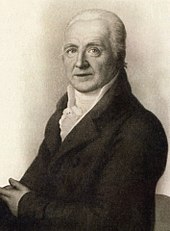Johann Heinrich Seidel
Johann Heinrich Seidel (born November 22, 1744 in Radeberg ; † January 30, 1815 in Dresden ) was a Saxon court gardener and plant breeder. He was the founder of the Seidel family dynasty and is known as the "father of Dresden horticulture". In particular, his collection of over 4,000 plant species and varieties in the Duchess Garden achieved international renown and ensured that Dresden's horticulture was recognized worldwide.
family
Seidel's parents, Johann Georg and Anna Rosina (née Burckard), left Radeberg in 1751 and moved to Dresden with their children. Seidel had four brothers and two sisters. He was married to Johanna Eleonora Seidel (née Fleischer). Of their ten children (five sons and five daughters), four sons also embarked on a horticultural career: Friedrich Jakob and Traugott Leberecht founded the Seidel gardening company , which gained international recognition, Carl August succeeded Johann Heinrich as court gardener, and Gottlob Friedrich became a commercial gardener and Seed dealer.
Life
Seidel completed an apprenticeship as a gardener with the electoral art gardener of the Dresden Great Garden, Johann Jeremias Unger. He then went on a journey through Germany, Austria, Belgium, the Netherlands, England and France for seven years . He worked for a long time in the gardens Het Loo , Jardin des Plantes , Chiswick and Kew Garden . After his return to Dresden he was employed in 1771 as an adjunct and from 1779 as the electoral court gardener in the Duchess garden . Seidel was a member of the Leipzig Economic Society .
Seidel began to create one of the largest European plant collections of his time. Plant catalogs record around 1800 species and varieties for 1794, and 4300 different plants have come down to us for 1806. In the winter of 1792/93 he was one of the first German gardeners to start breeding camellias . Seidel's plant collection was also known to the poet Johann Wolfgang von Goethe , who visited Seidel at least five times in Dresden between 1794 and 1813. Goethe incorporated the knowledge gained from discussions with Seidel and studying his collection into his work The Metamorphosis of Plants . Goethe reports on his visits to Seidel in 1831, among other things, in his essay Effect of my writing on the metamorphosis of plants and further development of the idea presented in it .
The camellia collection at Castle Beimendorf near Pirna has its origins in the breeding of Seidel and his descendants.
Publications
- Synonymic directory of all in the Churfürstl. Orange garden in Dresden , Dresden 1799.
- Synonymic directory of all warm and cold house plants, which are in the Königl. Orange Garden in Dresden , Dresden 1811.
literature
- Mustafa Haikal : The camellia forest . The story of a German nursery. 3rd revised and expanded edition. Sandstein Verlag , Dresden 2010, ISBN 978-3-942422-17-8 .
- State Office for Environment, Agriculture and Geology , State Association of Horticulture Saxony, Association of former Dresden-Pillnitzer (Ed.): 200 years of ornamental plant cultivation in Saxony . Laske-Druck, Pirna 2013.
Web links
- Felix Pietschmann: Johann Heinrich Seidel . In: Institute for Saxon History and Folklore (Ed.): Saxon Biography .
- German biography
Individual evidence
- ↑ a b c d Saxon biography
- ↑ Goethe, Seidel and the camellias. Förderverein Landschloss Pirna -zutendorf eV, accessed on January 13, 2015 .
- ^ Digitized version at the University and State Library of Saxony-Anhalt
| personal data | |
|---|---|
| SURNAME | Seidel, Johann Heinrich |
| BRIEF DESCRIPTION | German gardener and plant breeder |
| DATE OF BIRTH | November 22, 1744 |
| PLACE OF BIRTH | Radeberg , Germany |
| DATE OF DEATH | January 30, 1815 |
| Place of death | Dresden , Germany |

